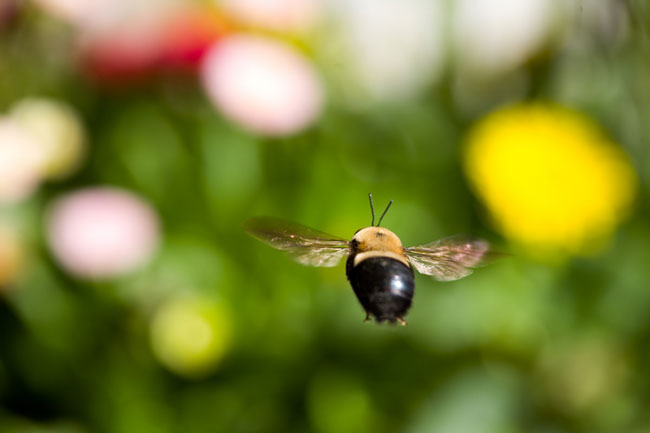Bees See Color 3 Times Faster Than Humans

Bees see color at about triple the speed that humans do, a new study finds.
The findings are the first to measure bumblebee color vision speed and show how it compares with that of monochromatic vision, or the "black-and-white" vision used to track motion.
Since speedy vision takes up quite a bit of energy, the results suggest seeing quickly in color must be rather valuable for bees.
"Color vision doesn't have to be so fast — if you want to track something moving accurately you need fast processing to track its changing position, but objects don't change color rapidly, that tends to be a permanent feature," said study author Peter Skorupski, a researcher at Queen Mary, University of London, in England. "[The results] suggest to us that color vision must be pretty important in the life of a bumblebee."
Quick eyes
How fast an organism sees depends on how quickly the light-detecting cells in the eyes, called photoreceptors, can respond to changes in light and send signals to the brain. For instance, fast-flying insects like flies have speedy sight, which explains why humans have trouble swatting them.
But the quick vision comes with a cost. "Fast photoreceptors are expensive, and so an animal shouldn’t really go investing in that expense unless it really needs to," Skorupski said.
Sign up for the Live Science daily newsletter now
Get the world’s most fascinating discoveries delivered straight to your inbox.
Skorupski and his colleagues used a tiny electrode to measure how fast the bumblebee photoreceptors responded to changes in light.
As expected, the quickest responses came from the receptors in charge of monochromatic vision. This "black and white" vision was about four to five times faster than human vision, depending on how it was measured Skorupski said.
But the color vision was still pretty quick relative to other animals, and about 3 to 4 times faster than human color vision, also depending on the way it's measured.
Such speed indicates color vision must play a key role for bumblebees. "I think we can assume the bees wouldn't be needlessly profligate in that way," Skorupski said.
Why so fast?
Bees probably use their color vision to help identify flowers. But since flowers remain relatively still, this doesn't explain why bee color vision needs to be so fast.
The researchers suggest this high-speed vision might come in handy when bees need to keep track of color in flickering light, which could happen when the insect is flying quickly through a bush.
"The scene for the bee would be flickering with different amounts of light and shade, and the color view is potentially changing, from a flower reflecting more light to less light," Skorupski said. Fast color vision might help bees accurately perceive color in this situation, he said.
The results were published March 17 in the Journal of Neuroscience.
- Top 10 Amazing Animal Abilities
- Bees See Your Face as a Strange Flower
- Origins of Vision Discovered

Rachael is a Live Science contributor, and was a former channel editor and senior writer for Live Science between 2010 and 2022. She has a master's degree in journalism from New York University's Science, Health and Environmental Reporting Program. She also holds a B.S. in molecular biology and an M.S. in biology from the University of California, San Diego. Her work has appeared in Scienceline, The Washington Post and Scientific American.









